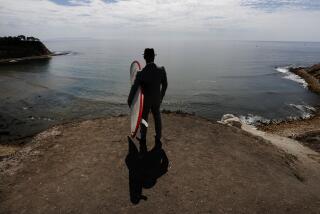Sea Wall Plan for Surfers Point Hit by Wave of Protest at Forum
- Share via
Dozens of residents who attended a workshop on ways to restore Surfers Point criticized plans to build a sea wall at the north end of the popular downtown Ventura beach, saying the expensive concrete barrier would be ugly and would not prevent erosion.
The restoration proposal, which could cost $5 million to $8 million, calls for reclaiming much of the beach by moving an adjacent bike path more than 60 feet inland. The damaged parking lot next to Surfers Point would be razed and replaced with 244 public parking spaces along a widened Shoreline Drive, the road that encircles the Ventura County Fairgrounds.
“This sounds like a very expensive bike path,” said Ventura resident David Grau, who attended Thursday night’s workshop at Seaside Park. “You are looking at spending $8 million for a Band-Aid, and that’s a waste of money.”
City engineer Rick Raives told the audience that alternate proposals include adding a 50-foot-wide layer of natural rock, known as “cobble,” beneath the sand along with a 40-foot sand dune behind Surfers Point to protect it from the waves and to prevent erosion of a new bike path.
Many of the nearly 80 people at the workshop, including a large and vocal contingent from the city’s surfing community, maintained that a man-made bike path was not worth protecting.
Calling beach restoration efforts “notoriously failure-prone,” Patricia Anderson, an environmental activist from Ventura, suggested officials remove the bike path and parking lot and let the work of winter storms gradually return the beach to its natural state.
“Maybe the bike path didn’t belong there in the first place--if Mother Nature is left to do her work, the beach will take care of itself,” she said.
City officials acknowledged that the plan, which took the Surfers Point Working Group six years to develop, was a compromise rather than the most scientifically or ecologically sound approach.
The group includes representatives from the Ventura Fairgrounds, which owns the parking lot; the state parks department, which owns the bike path; the city, which owns Shoreline Drive; along with the California Coastal Commission, the offices of local state legislators, the county chapter of the Surfrider Foundation, and the Full Sail Windsurfing Club.
“The difficulty of this project is there are so many competing interests that need to be accommodated so everyone needs to give a little,” said Richard Parsons, the city’s project manager for Surfers Point.
Parsons said the problems at Surfers Point date to 1989--the year the bike path, parking lot and Shoreline Drive were built. Two years later the first chunks of the bike path were lost to pounding surf and erosion. Since then, the damage has progressed so that now only 223 of the lot’s original 352 spaces can be used.
Parsons said the sea wall, which would be mostly buried in the sand far from the shoreline, would not be unsightly and its distance from the ocean would not contribute to beach erosion as it might if it were closer to the water’s edge.
Parsons said suggesting the bike path be moved farther inland--north of Shoreline Drive or along Figueroa Street--misses the point. “Bicyclists want to ride along the shoreline. That’s what makes that bike path so popular,” he said.
James Balders, a board member of the Ventura County Bicycle Coalition, agreed, saying cyclists, joggers, parents with strollers, and people in wheelchairs rely on the bike path for “reasonable access to the beach environment.”
The Surfrider Foundation has developed a separate alternative, which Paul Jenkin, the group’s environmental director, said combines the “best elements” of the other plans. Surfrider suggests rebuilding the dunes and depositing cobble and sand where the parking lot and bike path are, but not installing a sea wall.
Parsons and Raives said that option, while providing a sandy beach, wouldn’t hold up well to erosion. “In a sense, the project itself is a mitigation measure for past mistakes,” Parsons said.
More to Read
Sign up for Essential California
The most important California stories and recommendations in your inbox every morning.
You may occasionally receive promotional content from the Los Angeles Times.










